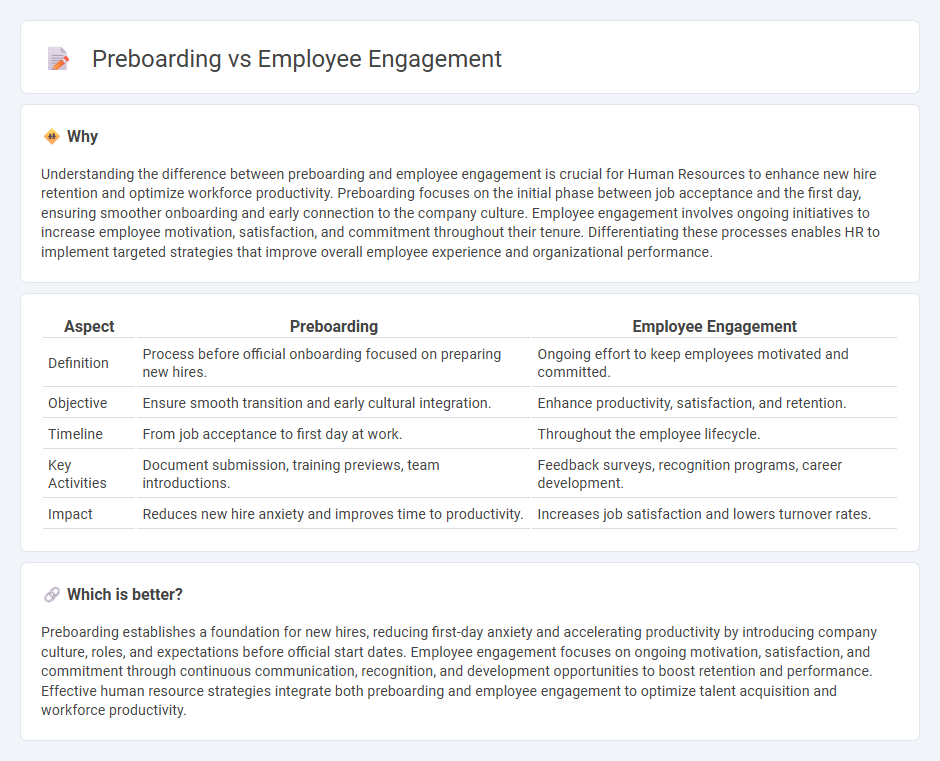
Preboarding sets the foundation for a new hire's experience by providing necessary information and resources before their first day, enhancing initial engagement and reducing turnover. Employee engagement focuses on fostering ongoing motivation, commitment, and satisfaction through continuous support, recognition, and development opportunities. Discover how integrating effective preboarding strategies can significantly boost long-term employee engagement.
Why it is important
Understanding the difference between preboarding and employee engagement is crucial for Human Resources to enhance new hire retention and optimize workforce productivity. Preboarding focuses on the initial phase between job acceptance and the first day, ensuring smoother onboarding and early connection to the company culture. Employee engagement involves ongoing initiatives to increase employee motivation, satisfaction, and commitment throughout their tenure. Differentiating these processes enables HR to implement targeted strategies that improve overall employee experience and organizational performance.
Comparison Table
| Aspect | Preboarding | Employee Engagement |
|---|---|---|
| Definition | Process before official onboarding focused on preparing new hires. | Ongoing effort to keep employees motivated and committed. |
| Objective | Ensure smooth transition and early cultural integration. | Enhance productivity, satisfaction, and retention. |
| Timeline | From job acceptance to first day at work. | Throughout the employee lifecycle. |
| Key Activities | Document submission, training previews, team introductions. | Feedback surveys, recognition programs, career development. |
| Impact | Reduces new hire anxiety and improves time to productivity. | Increases job satisfaction and lowers turnover rates. |
Which is better?
Preboarding establishes a foundation for new hires, reducing first-day anxiety and accelerating productivity by introducing company culture, roles, and expectations before official start dates. Employee engagement focuses on ongoing motivation, satisfaction, and commitment through continuous communication, recognition, and development opportunities to boost retention and performance. Effective human resource strategies integrate both preboarding and employee engagement to optimize talent acquisition and workforce productivity.
Connection
Preboarding sets the foundation for strong employee engagement by familiarizing new hires with company culture, expectations, and resources before their official start date. Effective preboarding reduces first-day anxiety and accelerates productivity, fostering a sense of belonging and commitment from the outset. This proactive approach leads to higher retention rates and sustained employee satisfaction throughout their tenure.
Key Terms
**Employee Engagement:**
Employee engagement drives productivity, retention, and workplace satisfaction by fostering emotional commitment to the organization's goals. Preboarding serves as a critical phase to enhance engagement by acclimating new hires with company culture and expectations before day one. Explore more strategies to elevate employee engagement and optimize talent performance.
Motivation
Employee engagement drives motivation by fostering a sense of purpose and belonging, leading to higher productivity and job satisfaction. Preboarding enhances motivation by providing new hires with clear expectations, resources, and early connection to company culture before their first day. Explore the impact of motivational strategies in both employee engagement and preboarding to elevate workforce performance.
Recognition
Employee engagement thrives on consistent recognition that reinforces motivation and loyalty, while preboarding recognition sets a positive tone for new hires, fostering early connection to company values. Effective recognition during preboarding can reduce turnover and accelerate integration, creating a foundation for long-term engagement. Explore strategies to leverage recognition for maximizing employee commitment from day one.
Source and External Links
Why employee engagement is key to company success - Employee engagement leads to higher productivity, retention, and profitability by creating a culture where employees feel valued and connected, with engagement driving productivity increases of up to 18% and boosting profitability by 23%.
How to Improve Employee Engagement in the Workplace - Engaged employees show significantly higher productivity, reduced absenteeism and turnover, fewer safety incidents, and stronger customer loyalty, according to decades of Gallup research showing median productivity gains of 14-18% and profitability gains of 23%.
What is Employee Engagement? (And How to Boost It) - Employee engagement involves employees feeling valued, involved, and connected to their company, which increases discretionary effort, improves retention, lowers absenteeism (by 41%), and leads to a 17% productivity increase compared to less engaged peers.
 dowidth.com
dowidth.com